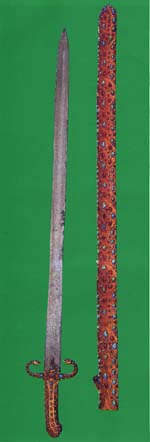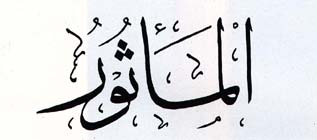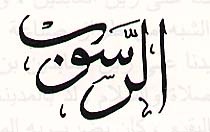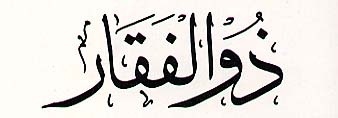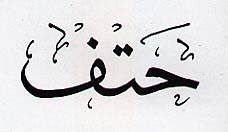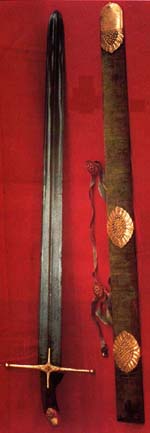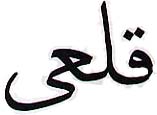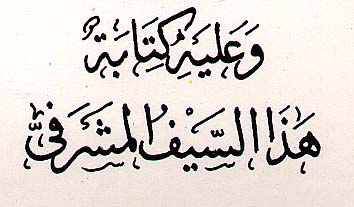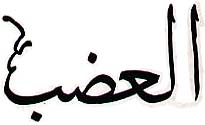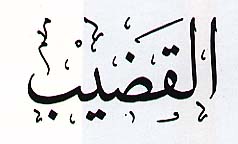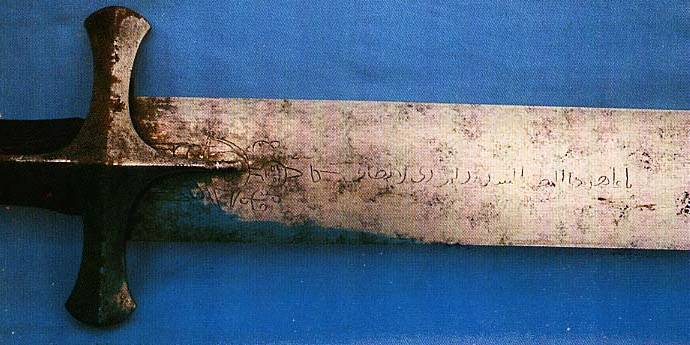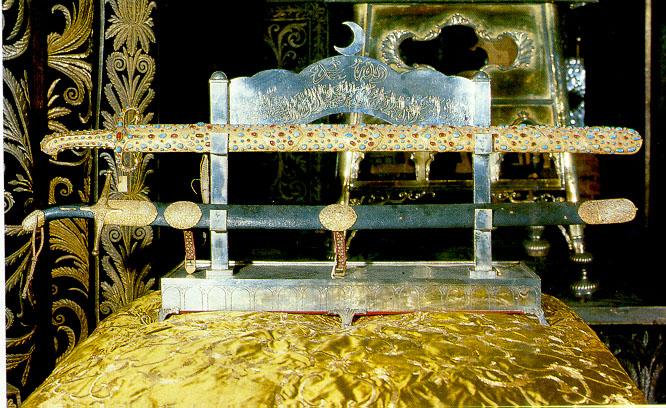About the swords of the Prophet
sallAllah `aleihi wa sallam
sallAllah `aleihi wa sallam
There are nine swords of the
Prophet Muhammad, which are preserved in the Topkapi Museum, Istanbul:
"Al-Ma'thur"
– a precious sword
which he inherited from his father, `Abd
Allah ibn Muttalib
"Al-Rasub", a long and sturdy sword for battle.
Three swords which he acquired as booty from the Jewish tribe Qaynaqa:
"Al-Battar". "Hatf" and "Qal`a", the most remarkable of which is
probably "Al-Battar", which is also called the
sword of the Prophets.
"Dhul Faqar", the sword "with two points", acquired in the battle of
Badr, which he gave to `Ali ibn Abi Talib.
"Al-`Adb" which he used in the Battle of Uhud.
"Mikhdham"and "Qadib" which are lighter swords for personal use, not
for battle.
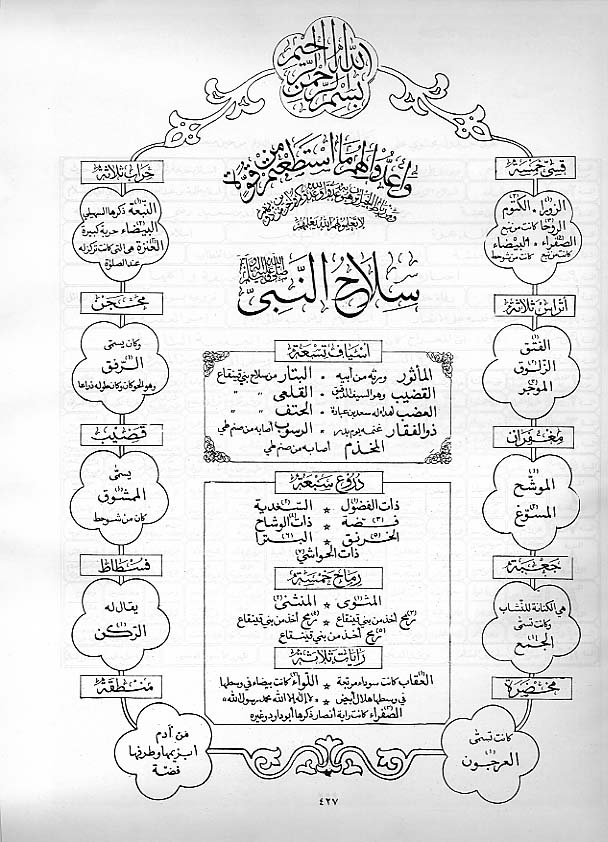

Topkapi Museum, Istanbul, Item No: 21/ 129
Ref: Meridyen Gallery
More info >>
Al-Ma'thur
Today the sword is housed in
the Topkapi Museum, Istanbul.
It is 99 cm in length, and its eight dimensional hilt is overlaid with gold. Its handle is a little curled. Its hilt has flower engravings and rubies and turquoises on the golden slots. The hilt is curvature towards the blade. The guard in the shape of a dragon head is decorated in parallel to the hilt. The writing of “Rasulallah” on the plain and sharp blade is barely readable. Its sheath is 85 cm in length. In accordance with the hilt, one face of its sheath is overlaid with gold. The other face of the sheath is embroidered with flower like motifs and cypress figures made of niello. It has a band made of red silk and having a circular buckle and casing made of green fabric embroidered flower motifs. The flower motif is protected in a green fabric on which it is written that it belongs to Prophet Muhammad (pbuh).
Ref: Meridyen Gallery
It is 99 cm in length, and its eight dimensional hilt is overlaid with gold. Its handle is a little curled. Its hilt has flower engravings and rubies and turquoises on the golden slots. The hilt is curvature towards the blade. The guard in the shape of a dragon head is decorated in parallel to the hilt. The writing of “Rasulallah” on the plain and sharp blade is barely readable. Its sheath is 85 cm in length. In accordance with the hilt, one face of its sheath is overlaid with gold. The other face of the sheath is embroidered with flower like motifs and cypress figures made of niello. It has a band made of red silk and having a circular buckle and casing made of green fabric embroidered flower motifs. The flower motif is protected in a green fabric on which it is written that it belongs to Prophet Muhammad (pbuh).
Ref: Meridyen Gallery
Al-Rasub
The al-Rasub sword is preserved
in
the Topkapi museum, Istanbul.
Dhul-Faqar
Hadith about Dhul Faqar:Ref: Al-Mawahib al-Ladunni, p. 216ff
Muhammad
ibn
Bashar
narrated
to
us:
Wahb
ibn Jarir narrated to us: my father
narrated to us from Qatada from Anas [ibn Malik] (raDiya Allah
´anh) who said: The handle [qabi´a] of the sword of the
the Messenger of Allah (s) was of silver.
The sword that is meant here is
Dhu al-Faqar. He (s) rarely parted from this sword. It was the sword
with which he (s) entered Makka on the day of its conqust. In this
hadith it states only that the utmost edge of its handle [al-qabi´a] was made of
silver. According to another narration from Ibn Sa´d from
´Amir: "´Ali ibn al-Husayn took out the the sword of the
Messenger of Allah (s) to us, and lo: the outmost end of its handle [al-qabi´a] was of silver, adn
its ring [halqatuhu] was of
silver." And from Ja´far ibn Muhammad from his father [Muhammad
al-Baqir]: "The bottom [na´l]
of
the
sword
of
the
Messenger
of Allah (s) - that is its lowest part -
was of silver, as well as its ring [halqatuhu]
and
its
handle
[qabi´atuhu]."
Hatf
closeup
closeup
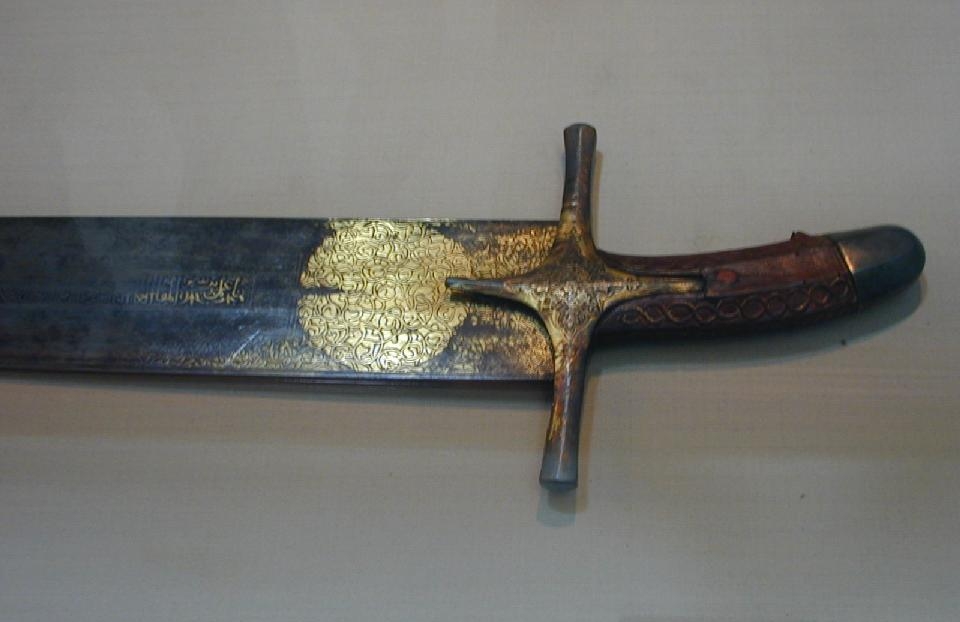
[click for enlargement]
Hatf
Today the "Hatf" sword is
housed in the Topkapi museum.
 Qal`i inscription
|
Qal`i
inscription |
Qal`i
more info
more info
The name relates the Qala3, a
place in the desert. [al-Bajuri: Al-Mawahib al-Laduniyya]
The name "Qal'i" or "Qul'ay" may be related to a place in Syria or a place in India near China. Other scholars state that the name refers to "tin" or "white lead" which was mined in different locations. I
t is also reported that the grandfather of the Prophet Muhammad discovered "swords of Qal'i" when he uncovered the Well of Zamzam in Mecca.
Today the sword is preserved in the Topkapi Museum, Istanbul.
[B. Wheeler]
The name "Qal'i" or "Qul'ay" may be related to a place in Syria or a place in India near China. Other scholars state that the name refers to "tin" or "white lead" which was mined in different locations. I
t is also reported that the grandfather of the Prophet Muhammad discovered "swords of Qal'i" when he uncovered the Well of Zamzam in Mecca.
Today the sword is preserved in the Topkapi Museum, Istanbul.
[B. Wheeler]
 Al-Mikhdham
|
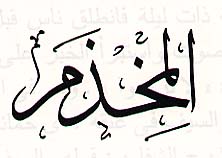 "Al-Mikhdham" was taken
as booty by Ali b. Abi Talib from a raid he led in Syria, according to
some reports. It was later passed back from the Prophet Muhammad
to Ali, and from him to his sons.
The blade is 97 cm in length and is inscribed with the name of Zayn al-Din al-Abidin. |
Mikhdham
The sword is now in the
Topkpoki Museum, Istanbul.
Al-`Adb
a
Topkapi Museum, Istanbul, Item No: 21/ 130
Ref: Meridyen Gallery
More info >>
Al-Qadib
Today the sword is housed in
the Topkapi Museum, Istanbul
It is 100 cm in length, and it has black leather hilt. Its hilt is curved and has flower engravings. Its blade is iron and one-sided. The silver engraving on it, “Muhammad Rasulallah, Muhammad ibn Abdullah ibn Abdulmuttalib” is still readable. The sheath which is leather binding, the guards and its two buckles are golden. It weights 930 gram without the sheath and 1684 gram including the sheath.
Ref: Meridyen Gallery
It is 100 cm in length, and it has black leather hilt. Its hilt is curved and has flower engravings. Its blade is iron and one-sided. The silver engraving on it, “Muhammad Rasulallah, Muhammad ibn Abdullah ibn Abdulmuttalib” is still readable. The sheath which is leather binding, the guards and its two buckles are golden. It weights 930 gram without the sheath and 1684 gram including the sheath.
Ref: Meridyen Gallery
 Al-Battar
|
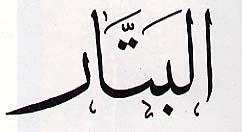 "Al-Battar" is called the
"sword of the Prophets". It originally belonged to Goliath and was
taken as booty by Prophet Dawud (David). Prophet Muhammad acquired it
as
booty from Banu Qaynaqa (a Jewish tribe in Madina). Some report that it
is this sword that Prophet
Isa (Jesus) will use when he returns to Earth to defeat the al-Dajjal
(anti-Christ).
|
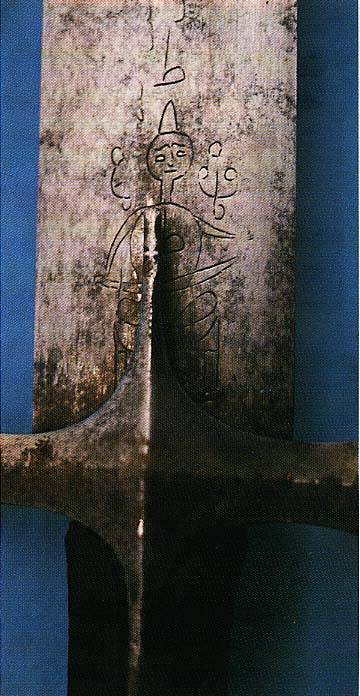 |
Al-Battar
drawing of Prophet Dawud killing Goliath Picture
engraved near the
handle of Al-Battar
|
Al-Battar
inscription of the names of Prophets
inscription of the names of Prophets
The blade of "Al-Battar" is
inscribed in Arabic with the names of the Prophets Dawud (David),
Sumayman (Solomon), Musa (Moses), Harun (Aaron), Joshua, Zachariah,
Yahya (John), `Isa (Jesus), and Muhammad.
Al-Battar
inscription
inscription
Al-Battar
more info
more info
Picture of King David
cutting off the head of Goliath at the
handle of al-Battar:
It is said that King David took his sword, "al-Battar", from Goliath as booty when he defeated him, but he was less than 20 years old. God gave King David the ability to work with iron, to make armor and weapons and instruments of war, and he made for himself a sword. It was thus that the Hatf sword came about, resembling the al-Battar but larger than it.
The sword is preserved in the
Topkapi
Museum, Istanbul.
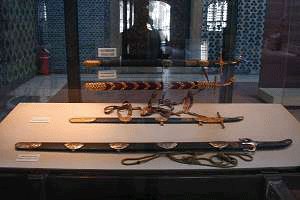
Top: Al-Battar [info]
Midde: [?]
Back: Al-Qadib [info]
Front: Al-Rasub [info]
Topkapi Museum, Istanbul
Hadith
about the weapons of the Prophet
(s)
from al-Sham'il
About his (s) swords [4 ahadith]
About his (s) mail coat [2 ahadith]
About his (s) mail cap [2 ahadith]
from al-Sham'il
About his (s) swords [4 ahadith]
About his (s) mail coat [2 ahadith]
About his (s) mail cap [2 ahadith]
Comments of Imam al-Bajuri
regarding the swords of the
Prophet (s)
Ref: Al-Mawahib al-Ladunni, p. 216ff
Ref: Al-Mawahib al-Ladunni, p. 216ff
It is one of his (s) miracles
is that when his (s) sword broke while
fighting ´Ikasha Jazl on the day of Badr, he said: "Hit (اضرب
به)", and a long
white sharp sword, extremely solid, came back to his (s) hands, and he
(s) fought with it. The one who witnessed this remained by his side saw
him with it until he was maryred. Also, while fighting 3b Allah b.
Jahsh on the day of Uhud, his (s) sword called "Asib Nakhl" (عصيب نخل)
broke, and a sword came back to his hand.
Sources
and
Acknowledgements
and
Acknowledgements
Photographs are taken from Muhammad Hasan Muhammad al-Tihami, Suyuf al-Rasul wa 'uddah harbi-hi (Cairo: Hijr, 1312/1992).
Compilation and info: B. Wheeler
Damas Cultural Society
2007
Latest update: 2007-11-24
Latest update: 2007-11-24
